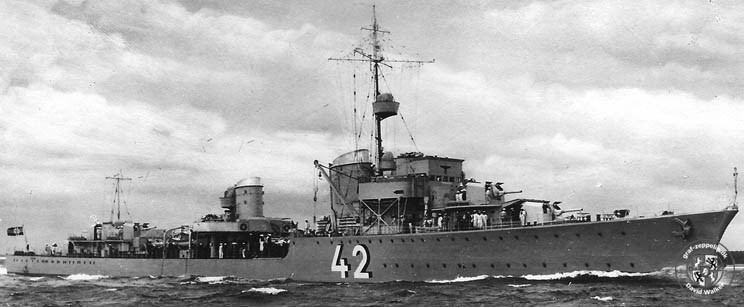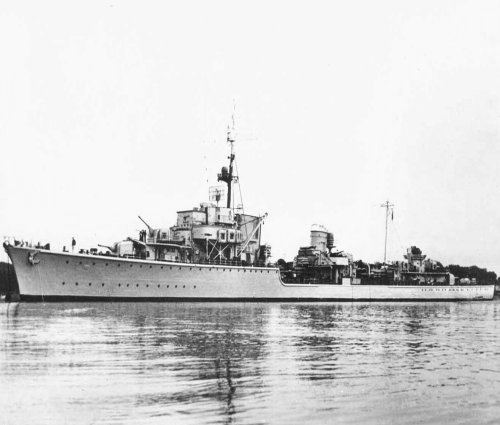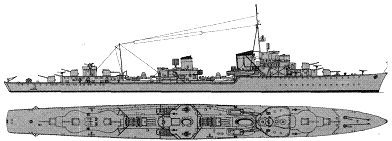Name Karl Galster Ordered 6 January 1936 Laid down 14 September 1936 Construction started 14 September 1936 Length 125 m | Namesake Karl Galster Yard number W922 Completed 21 March 1939 Launched 15 June 1937 Beam 12 m | |
 | ||
Builders Deutsche Schiff- und Maschinenbau, AG Weser | ||
Z20 Karl Galster was a Type 1936-class destroyer built for the Kriegsmarine in the late 1930s. It survived World War II and was handed over to the Soviet Union in 1946, where it served under the name Prochnyi. It was scrapped in 1956.
Contents

Design and description

Karl Galster had an overall length of 125.10 meters (410 ft 5 in) and was 120 meters (393 ft 8 in) long at the waterline. The ship had a beam of 11.80 meters (38 ft 9 in), and a maximum draft of 4.50 meters (14 ft 9 in). She displaced 2,411 long tons (2,450 t) at standard load and 3,415 long tons (3,470 t) at deep load. The two Wagner geared steam turbine sets, each driving one propeller shaft, were designed to produce 70,000 PS (51,000 kW; 69,000 shp) using steam provided by six high-pressure Wagner boilers with superheaters for a designed speed of 36 knots (67 km/h; 41 mph). Karl Galster carried a maximum of 739 metric tons (727 long tons) of fuel oil which gave a range of 2,050 nautical miles (3,800 km; 2,360 mi) at 19 knots (35 km/h; 22 mph). Her crew consisted of 10 officers and 313 sailors.

The ship carried five 12.7 cm SK C/34 guns in single mounts with gun shields, two each superimposed, fore and aft. The fifth mount was positioned on top of the rear deckhouse. Her anti-aircraft armament consisted of four 3.7 cm SK C/30 guns in two twin mounts abreast the rear funnel and six 2 cm C/30 guns in single mounts. The ship carried eight above-water 53.3-centimeter (21.0 in) torpedo tubes in two power-operated mounts. Four depth charge throwers were mounted on the sides of the rear deckhouse and they were supplemented by six racks for individual depth charges on the sides of the stern. Sufficient depth charges were carried for either two or four patterns of sixteen charges each. Mine rails could be fitted on the rear deck that had a maximum capacity of sixty mines. 'GHG' (Gruppenhorchgerät) passive hydrophones were fitted to detect submarines and an active sonar system was installed by the end of 1939.
Evacuation

With other ships, Karl Galster was assigned in 1945 to evacuate civilians and troops trapped in ports along the Baltic Sea by advancing Soviet forces. The survivors were transported to Copenhagen. When the German troops in Denmark surrendered on May 5, 1945, Karl Galster transferred survivors to smaller ships outside the harbour to avoid having to surrender. There the ship received an open radio transmission by Grand Admiral Dönitz asking "everybody to "Curry" who can make it until dawn on the 8th.". Dönitz had chosen the word "Curry" to make the British believe something harmless was going on, while the German captains knew "Curry" to be the nickname of their former naval academy instructor Admiral August Thiele, commander in Hela on the Hel Peninsula.

So Galster's final mission led to the Peninsula, which was one of the few remaining footholds on the coast under German control on the 8th of May 1945. At 10 p.m., two hours before the surrender became effective, Karl Galster, Friedrich Ihn, Z 25 and two torpedoboats, T 23 and T 28, picked up soldiers, including the survivors of Artillery Regiment 240. The ships took aboard some 1200 to 2000 soldiers each. Every German vessel located east of Bornholm at midnight was to return to a port under Soviet control, but Karl Galster, using its superior speed, managed to outrun pursuing Soviet torpedoboats and headed to Flensburg. From there the ship was sent to Kiel, where it surrendered to the British.

